[Atari 8-bits, Synapse Software]
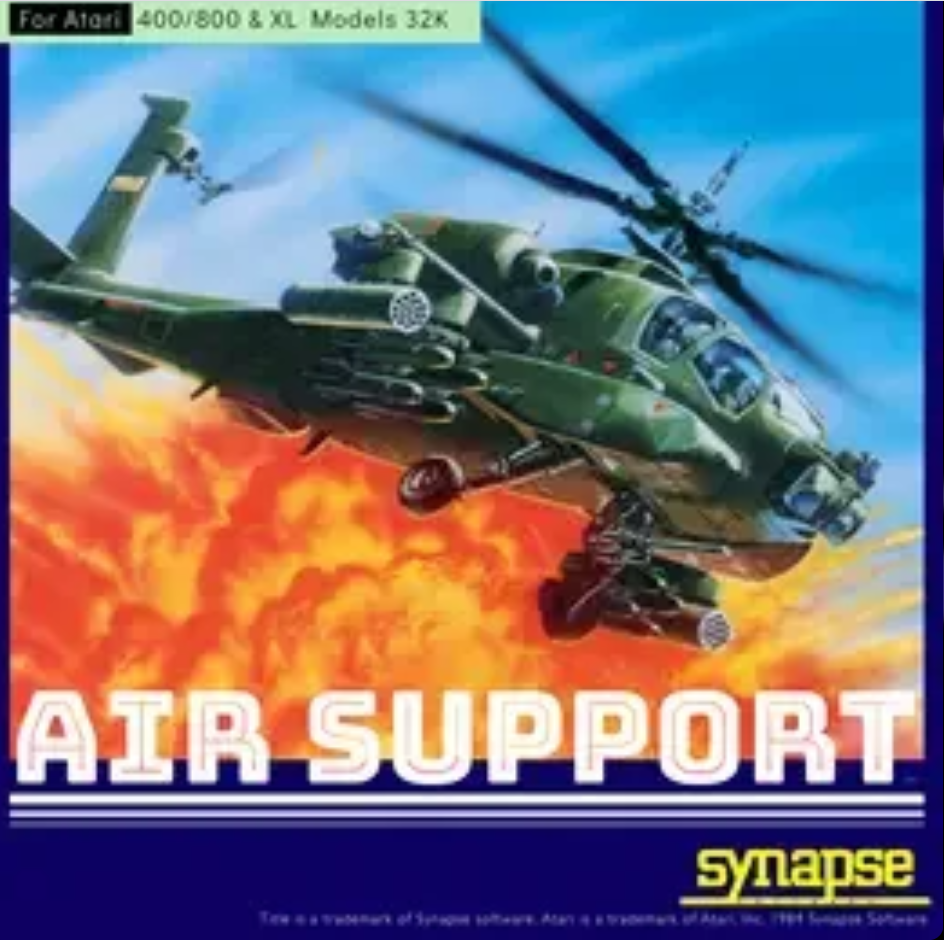
Air support is a 1984 game for Atari and Commodore 64 that weirdly got tagged in both Atarimania and Lemon64 as “Wargame”, though I don’t really see why.
In Air Support, the player pilots a helicopter and must provide, well, air support to an army of friendly blue robots.
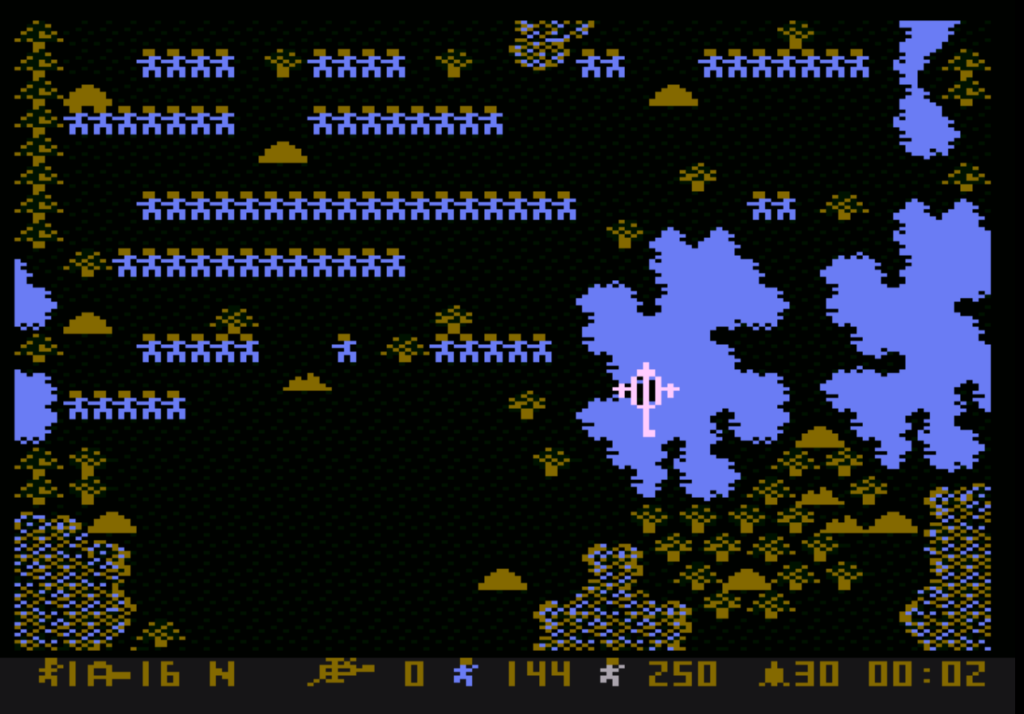
The friendly robots are deployed in line, and the objective in the first scenario is to prevent the enemy from crossing the map that is only one screen wide but spans vertically over multiple screens. This is fairly easy, as the enemy army has only 3 types of assets:
- AA missile launchers, which are the only hostiles able to destroy my chopper. They shoot at a moderate pace, though their projectiles are fast. They can be destroyed with a single bomb,
- “Twirlers”, which are hard to see on a static image. They are rotating pixels that are very dangerous for my robots, but harmless for me and easy to destroy,
- The white hostile robots, also easy to destroy, but there are a lot of them – 250 more specifically.
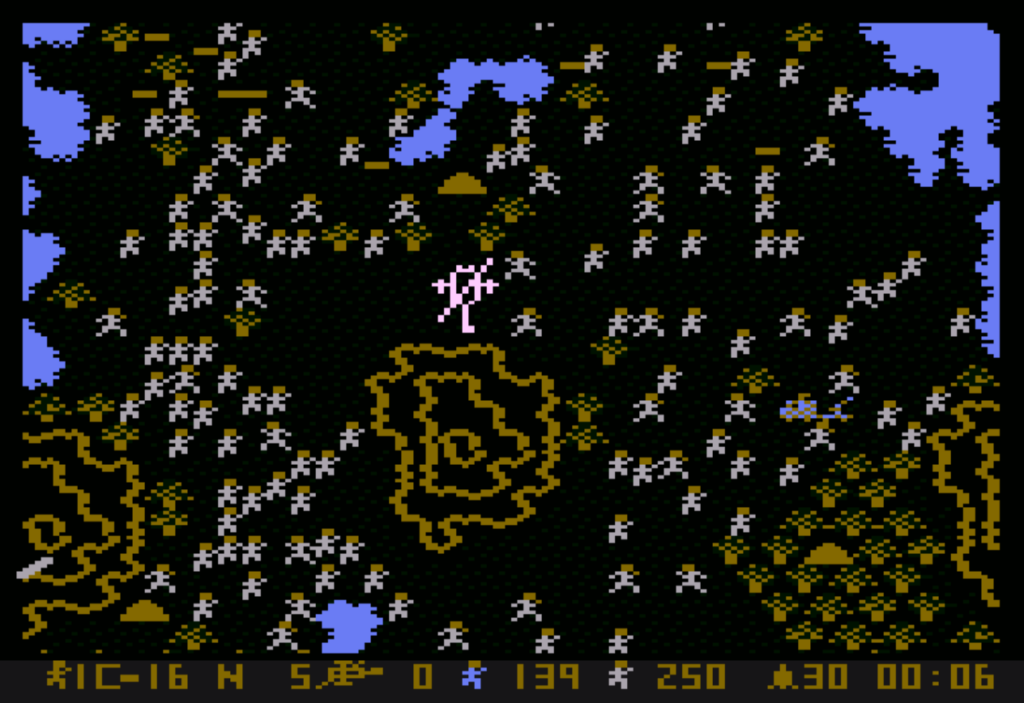
My choppers have 30 bombs, and receive 10 more every minute, so the game is trivial at default difficulty. After a quick raid to neutralize the AA missiles and the twirlers, I just have to bomb the enemy robot clusters – enemies don’t respawn!
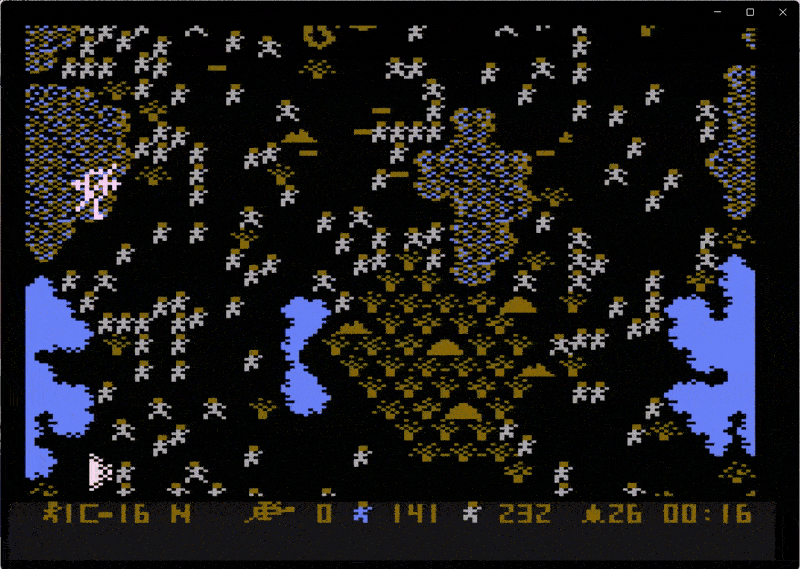
My initial attacks remove more than half of the enemy robots, and then my own robots easily hold the line:

Once the enemy force is broken, I can even order my robots to advance and mop-up the survivors. I guess that’s where the “strategy” tag comes from:
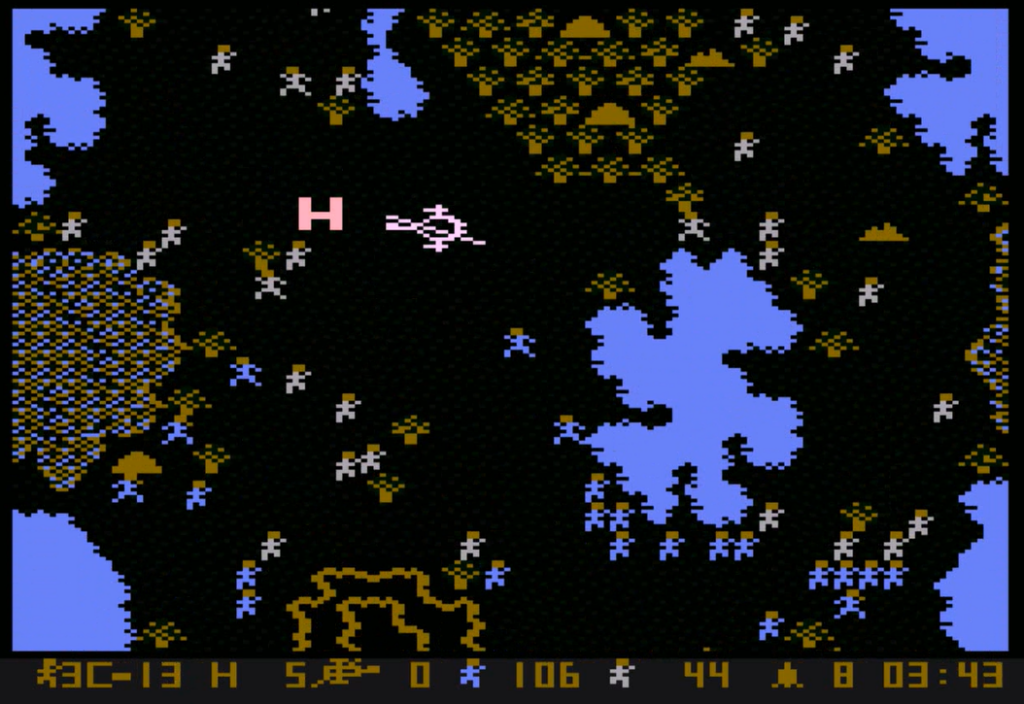
Anyway, I lose choppers stupidly because there are AA missiles at the top of the map I wanted to destroy even though I did not need to, but apart from that all went well:
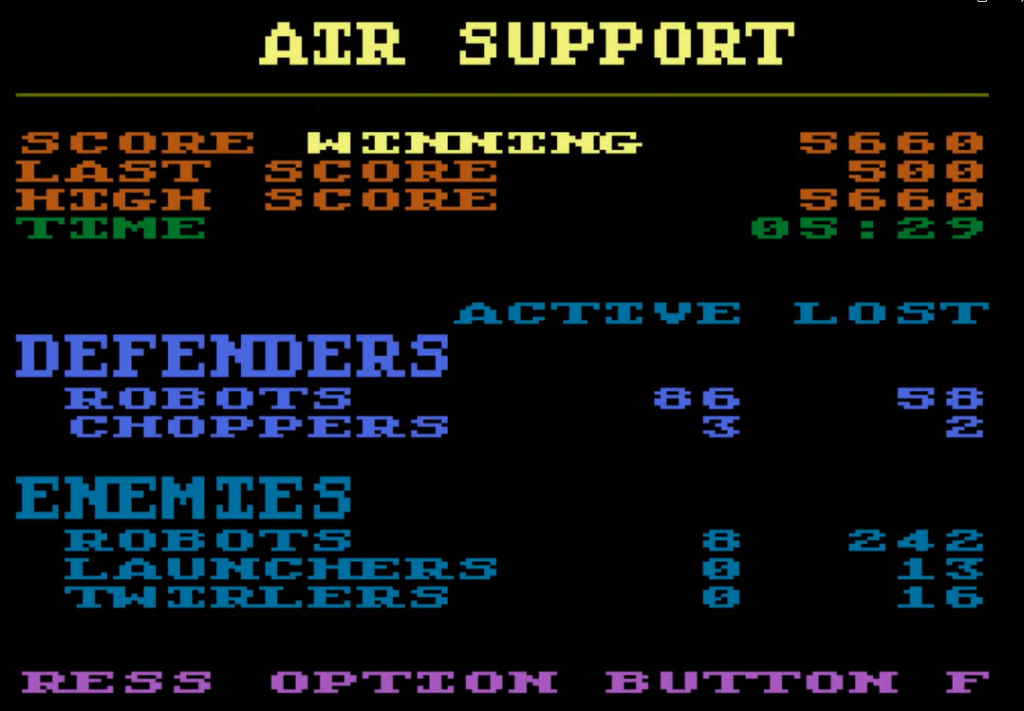
What else is there to say? Ah! The game has an option menu where you can select the number of robots, the speed of the game, which scenario you want to play and whether you want to play in arcade or strategy mod…
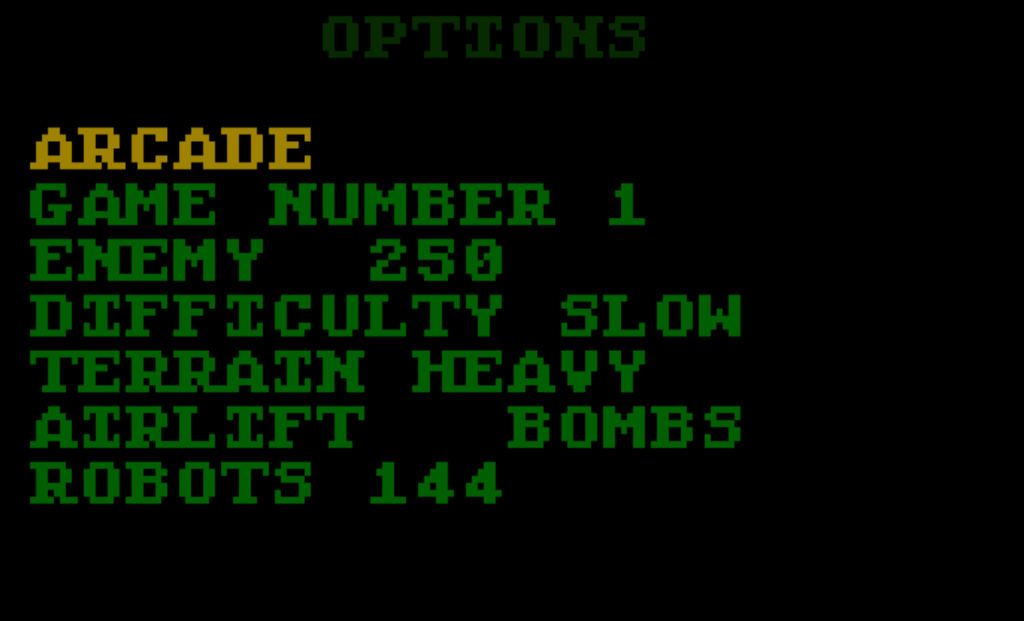
Wait…
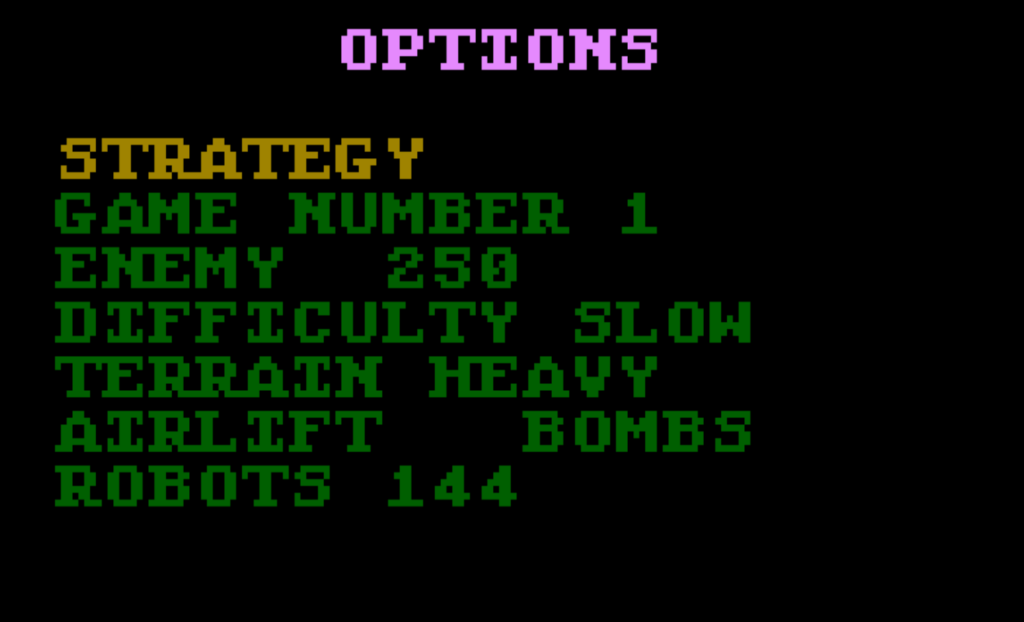
Oh boy!
Game #176: Air Support (1984)
[Atari 8-bits, Synapse Software]
So! Air Support! A strategy-hybrid game from Synapse Software. This time I choose the sixth scenario, in which I must capture 3 flags with my infantry. As I am in “strategy mode”, my chopper will only have 30 bombs in total, so I will have to use infantry this time.
Air Support proposes several formations for your infantry groups: lines (horizontal or vertical), short but large lines (horizontal or vertical) or “grouped around a point”. To take the first flag, I try a tacticool approach by ordering one squad left of the target and one squad South of the target, before ordering them to converge on the flag.
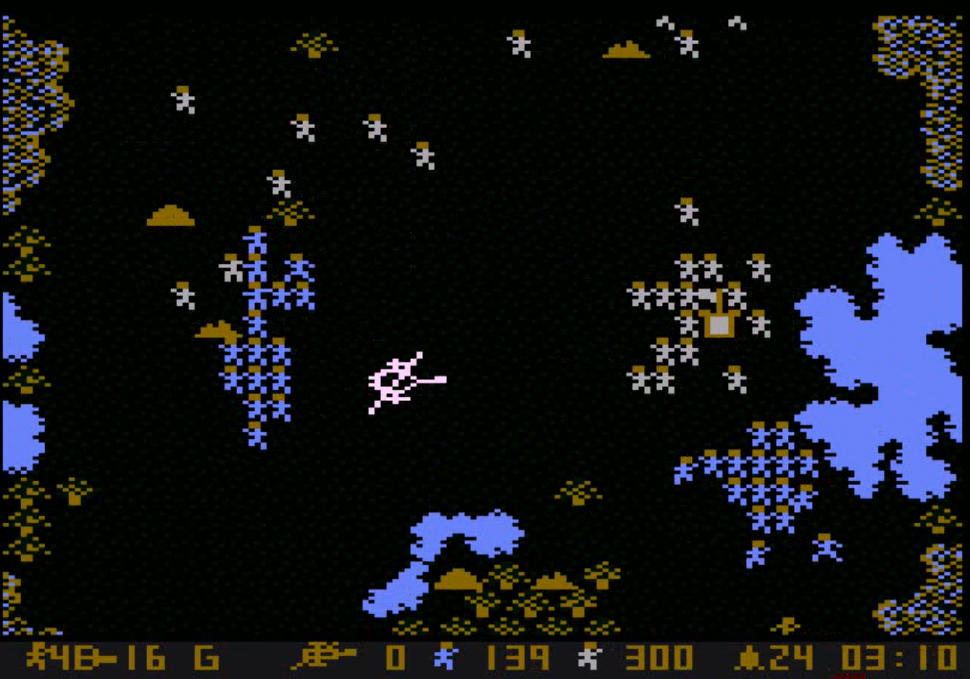
This is a decisive success, but I soon find a faster method. The helicopter can carry up to one squad of infantry, so it is just simpler to grab soldiers, clear the areas around the flags with bombs and then drop squads.
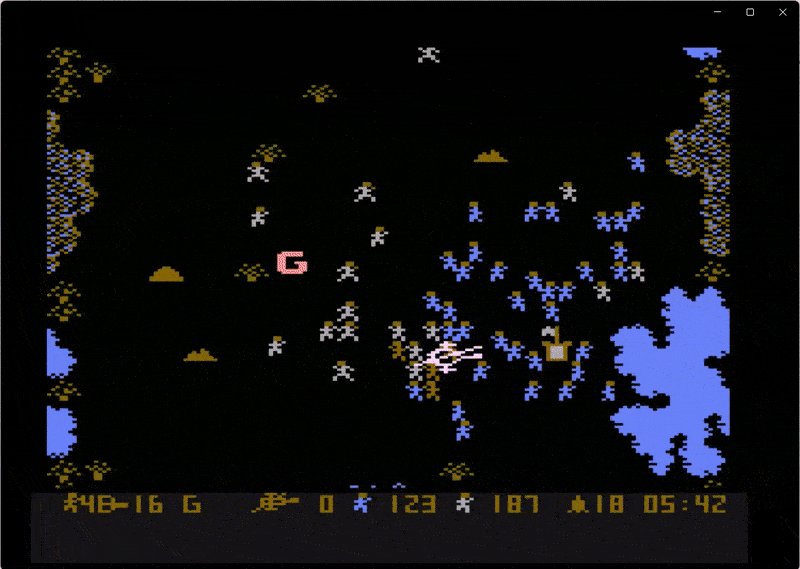
The white robots have no counter for this, because in strategy mode they have neither AA missiles nor twirlers. This is an easy victory for me, though a bit long as I must reduce the number of enemy robots to almost zero.
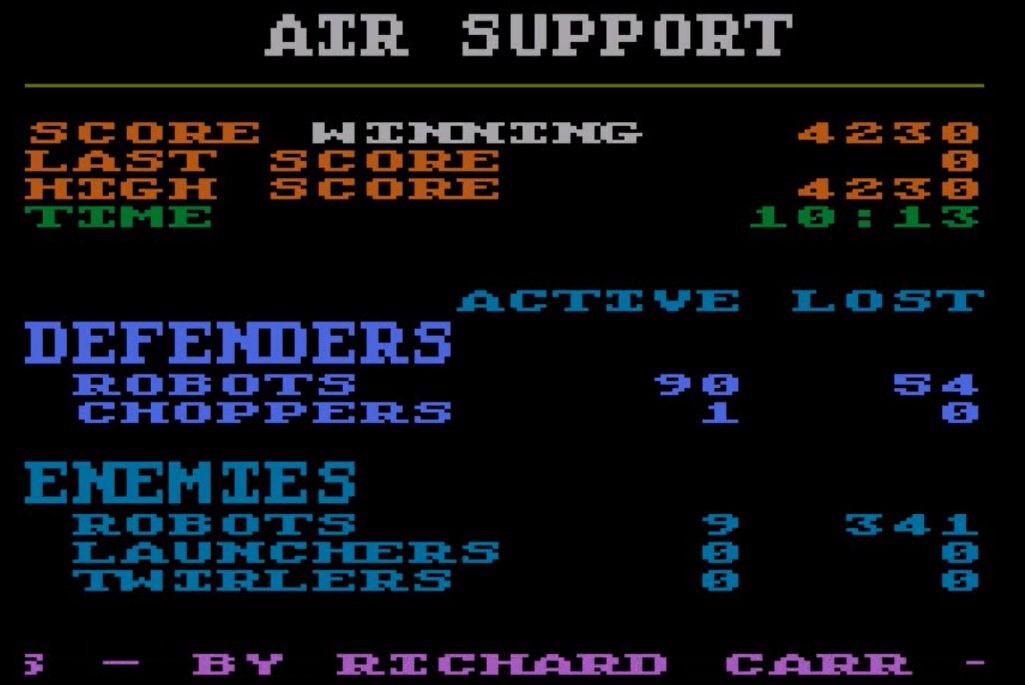
I thought we were back to BRIEF status, when I found this in the manual:

OK then, let’s play the real strategy game. The one without the airlift and the bombs.
Game #176: Air Support (1984)
[Atari 8-bits, Synapse Software]
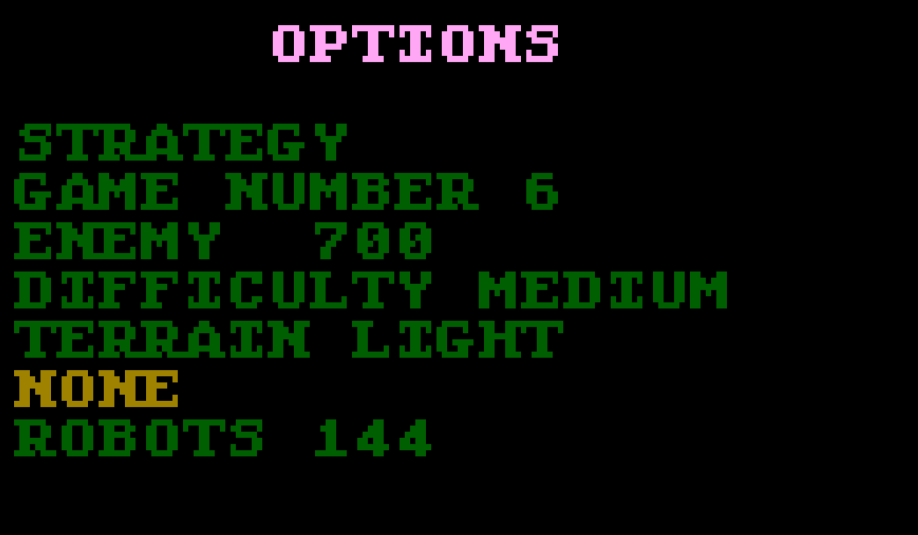
So Air Support, the game in which you lead your Civil War soldiers from a chopper, giving them orders through radio so they can fight with their little fists – that’s what the manual claims anyway.
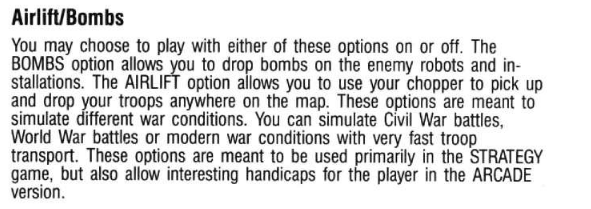
My bluecoats are just South of the first rebel flag, but some impossible terrain split my units in half. As I can only give order to full units and not individual soldiers, any subtle approach is impossible: I order them to converge toward the small passage between unreadable impassable terrain #1 and unreadable impassable terrain #2.
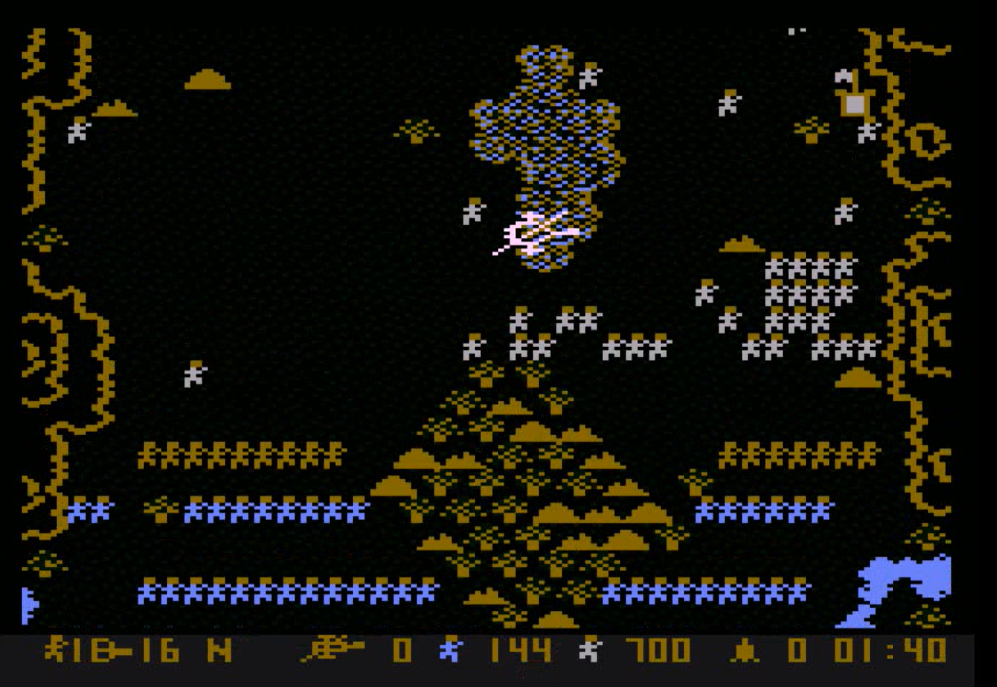
It’s a brutal melee around the flag, but I have critical mass and the Confederates don’t. The way combats are resolved in Air Support is that each unit receives the support of all those in a 5×5 square around it, though there is some randomness involved both as to the result of the battle and to the time it will take. My soldiers are also 50% better than my enemies according to the manual, so the combination of number and quality makes my attack devastating.

After leaving a garrison next to the first flag, I move a large force toward the second flag. A series of skirmishes as my troops move (during which they are most vulnerable to wander off alone in duels they don’t win) cost me some casualties, but eventually I approach the second narrow passage of the map.
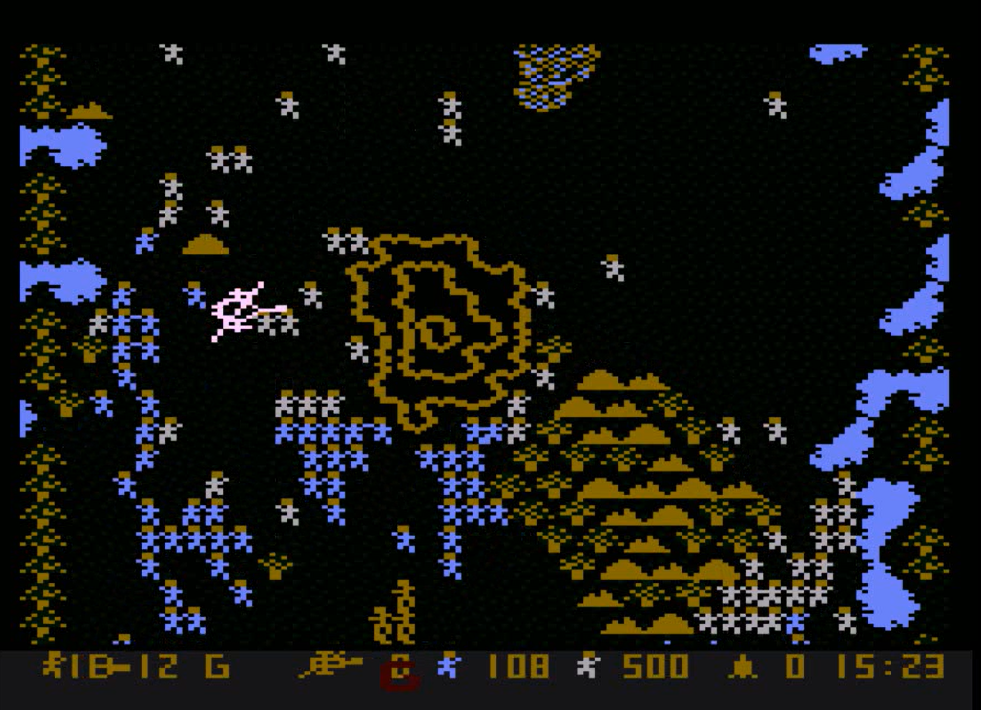
Combats can take a long time, so walls of soldiers form organically, and there is nothing else to do than trying to breach them by sheer force. This can be made difficult when Rebel reinforcements literally teleport behind my army and start enveloping it; luckily I had a reserve that I immediately use to envelop the envelopers.
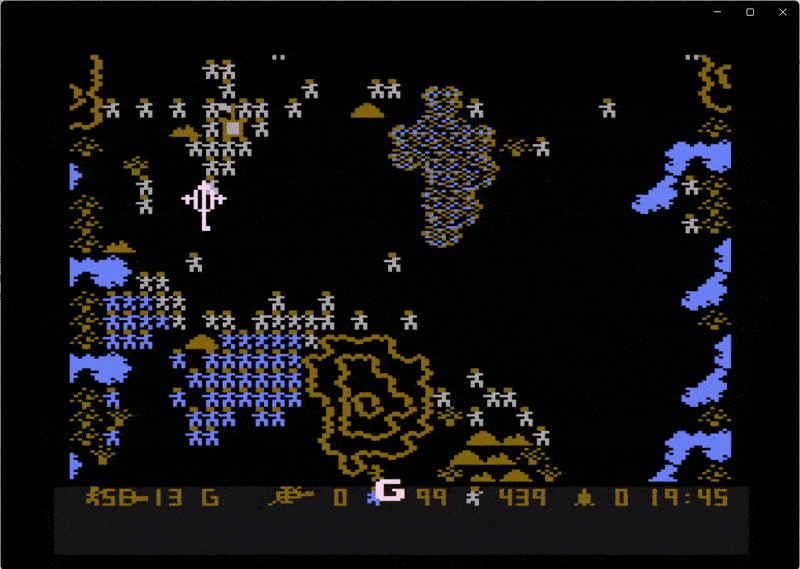
The battle continues for the second flag, with not a lot of tactics possible. Unfortunately, more Confederates in jetpacks (presumably) spawn behind my lines – and this time I don’t have reserves!
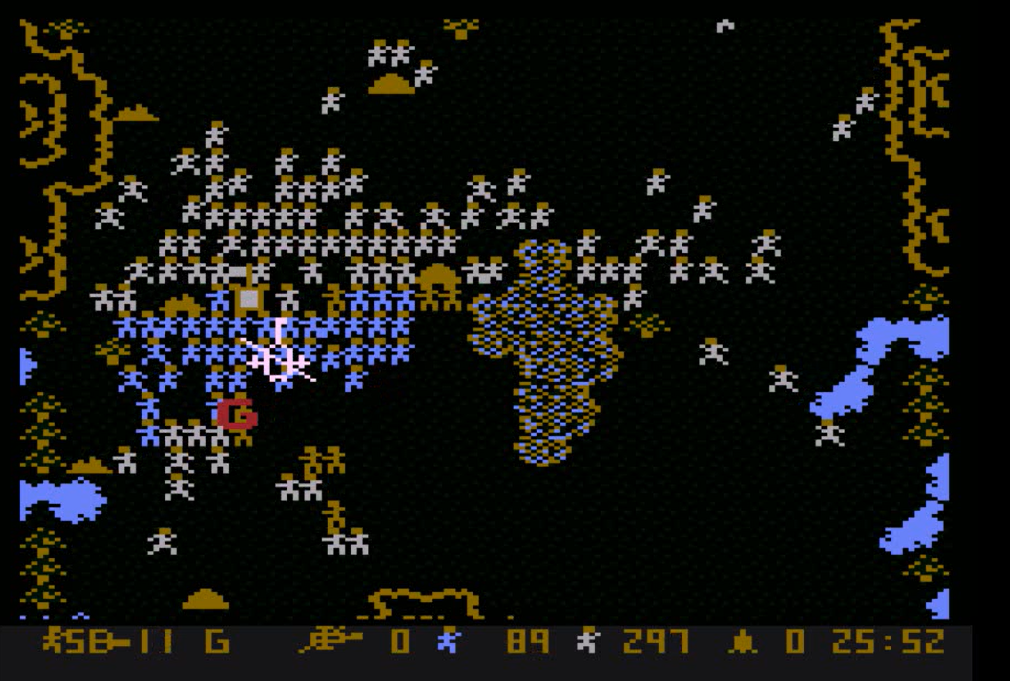
The situation next to the second flag is dire. I decide to call to the rescue the garrison of the first flag. They disentangle from the enemy forces in the general area and rush North.
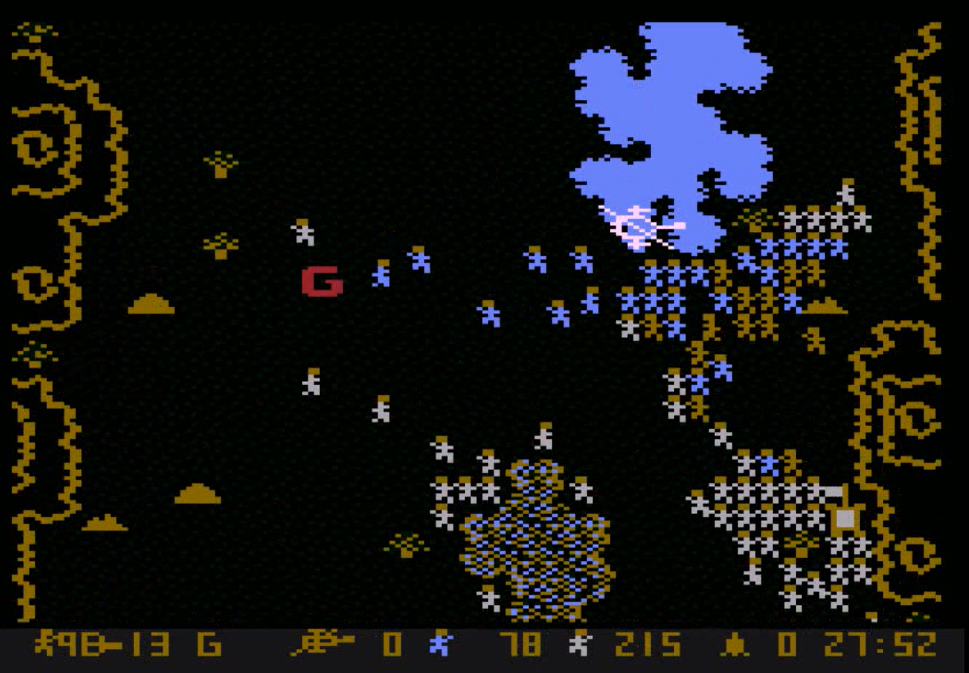
Many don’t make it, but those who arrive turn the tide of the battle of the second flag. When the combat ends, I have 43 soldiers left.
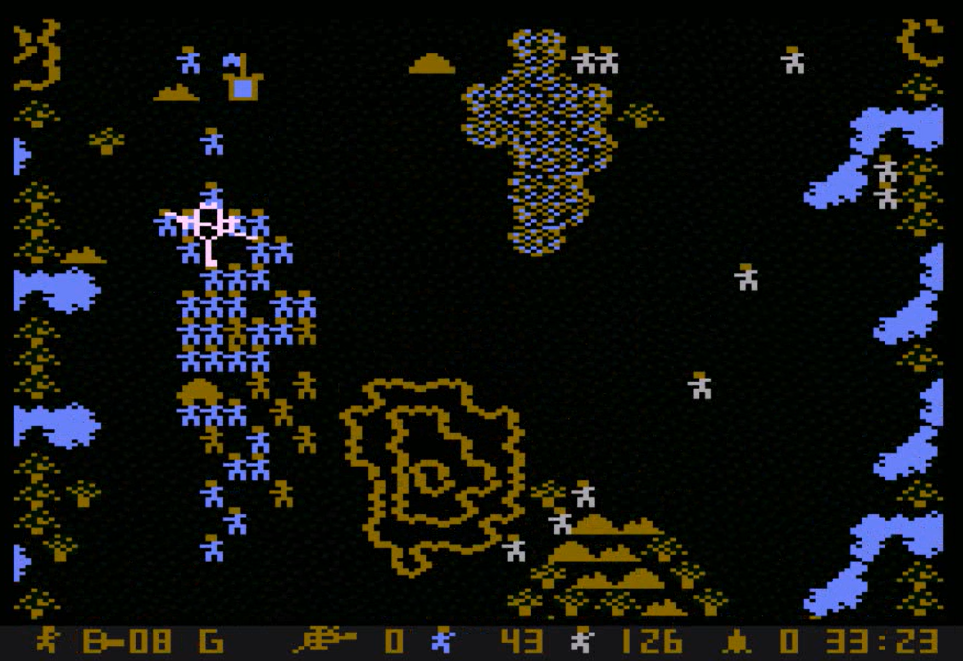
That’s when I remember there is a key to give orders to all groups at the same time. It is the only one I will be using from now on, sending 40+ fighters to isolated groups of 20 or so.
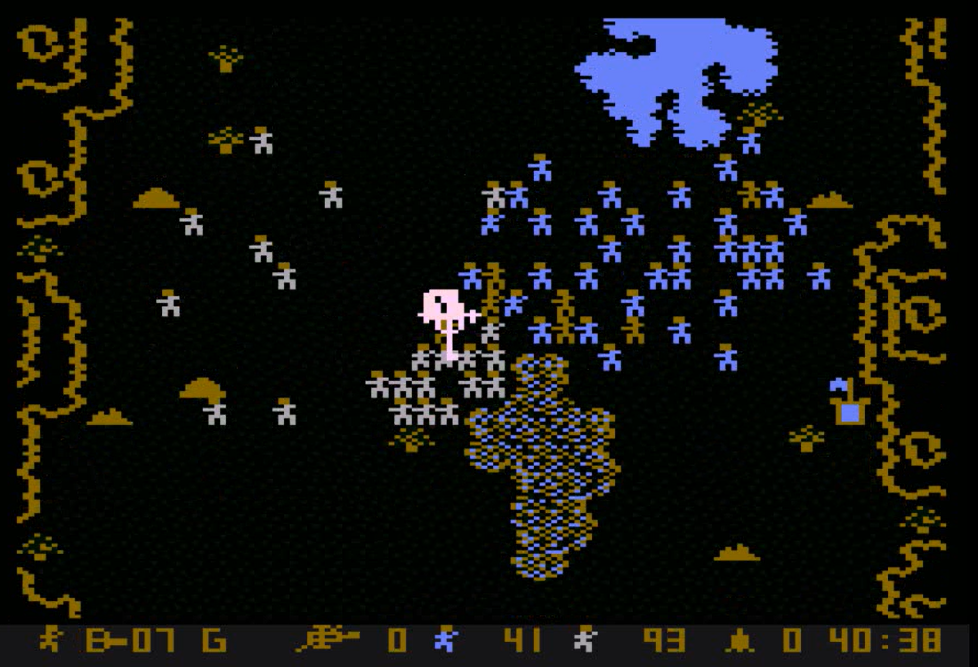
I do that until I kill all the enemy soldiers except 3, winning me the game.
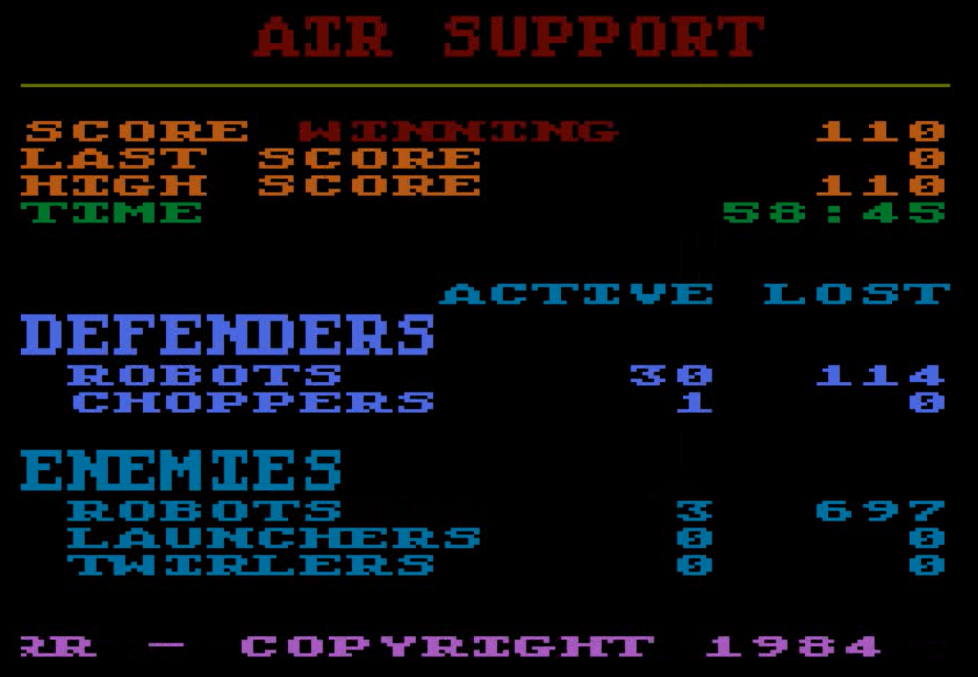
The flags? I never took control of all three, but obviously this was not necessary after all!
Ratings & Review
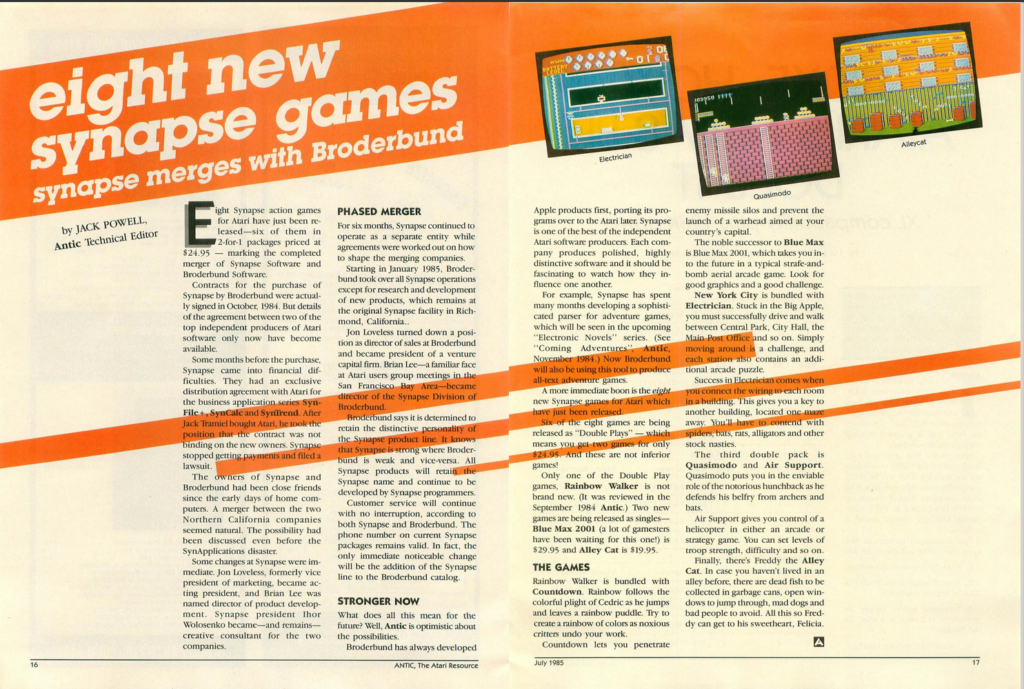
Air Support by Richard E. Carr, published by Synapse Software (US) and Brøderbund (US)
First release: August 1984 on Atari 8-bits and Commodore 64
Genre: Action-Strategy
Average duration of a battle: Around 1 hour at original speed
Total time played : 4 hours
Complexity: Low (1/5)
Final Rating: Totally obsolete
Context – Air Support is one of the very last games of Synapse Software, one of the superstars of Atari gaming founded in 1981 by Ihor Wolosenko and to which we owe Shamus (1982) or Alley Cat (1983), to mention the classics I played as a kid. I won’t get into the origins of Synapse Software – once again the Digital Antiquarian did it better than I ever could; suffice to say that Synapse Software was somewhat hit by the video game crash starting in 1983, but the blow was largely mitigated by its new Electronic Novels line of products. However, Synapse Software tried to shield itself even better from the vicissitudes of the gaming market by signing an exclusive distribution agreement with Atari for a series of business applications. This was trying to withstand a wave by binding oneself to a sinking ship, as Atari was devastated by the same crisis, and riddled with debt. When Jack Tramriel took the helms of Atari in July 1984, he characteristically refused to pay Synapse Software for their software – a common solution to liquidity issues, which of course immediately passed down the cash crisis to Synapse Software. Scrambling for a solution, Wolosenko asked to Brøderbund (he was a friend to its founder Doug Carlston) whether they could buy the company, which they promptly did in October 1984.
Given those circumstances, Air Support did not have much of a chance at release. It was released in the middle of these events, around August 1984 (based on the first video game store listing it), and Synapse Software did not push it with any advertisement that I could find. The game received a second chance when Brøderbund announced it as a new game in 1985. However, it does not seem to have had much success, as it was almost immediately sold as part of bundles with arcade games. Air Support, despite being released on both Atari and Commodore 64, doesn’t seem to have garnered any contemporary reviews.
I don’t have much information on Air Support‘s author Richard Carr. Synapse Software published another of his games back in 1982 (the arcade game Survivor) and then two more games in the early 90s, (Rescue and Capture the Flag) both of which are wargame-adjacent. Maybe I will cover them one day.
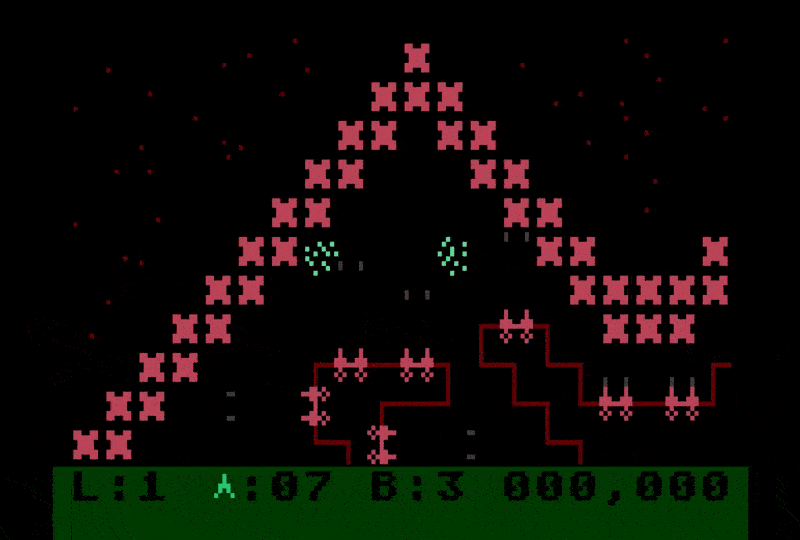
Traits – Air Support is a game that tries to do everything, and is adequate at nothing. To start with the arcade part: it is boring. The helicopter has no momentum so there is no joy in piloting it, and there are only 3 enemies, only one of which can hit your chopper. While the AA missile launchers are a real threat at the highest difficulty level, they also don’t respawn so after two or three minutes they’re gone, except maybe those in useless parts of the map. Once you’ve eliminated the missile launchers, the game is trivial as you just have to bomb the “twirlers” and then the infantry. The enemy robots attack so slowly that there is effectively no hard time limit.
This leaves the “strategy” part, which is not satisfying either. I like the random walk of your soldiers – it represents well command & control problems and creates an arbitrage between getting somewhere fast and getting somewhere with everyone. Alas, the game does not reward tactical maneuvering: your troops fight better the more numerous they are, the map is narrow, with choke-points that have to be brute-forced and the enemy can spawn anywhere on the map so keeping a reserve or leaving small garrisons behind will lose you robots. Furthermore, you seldom need to be somewhere fast as most of the scenarios require you to kill all the enemy robots to win, with the scenario specifics (eg: flags) mostly used to count points. Defensive scenarios with a lose condition (eg: “don’t lose all your flags“, or “don’t let the enemy cross the map“) are even worse, as you can just wait for the enemy to come to your 4-rank deep army and eventually win.
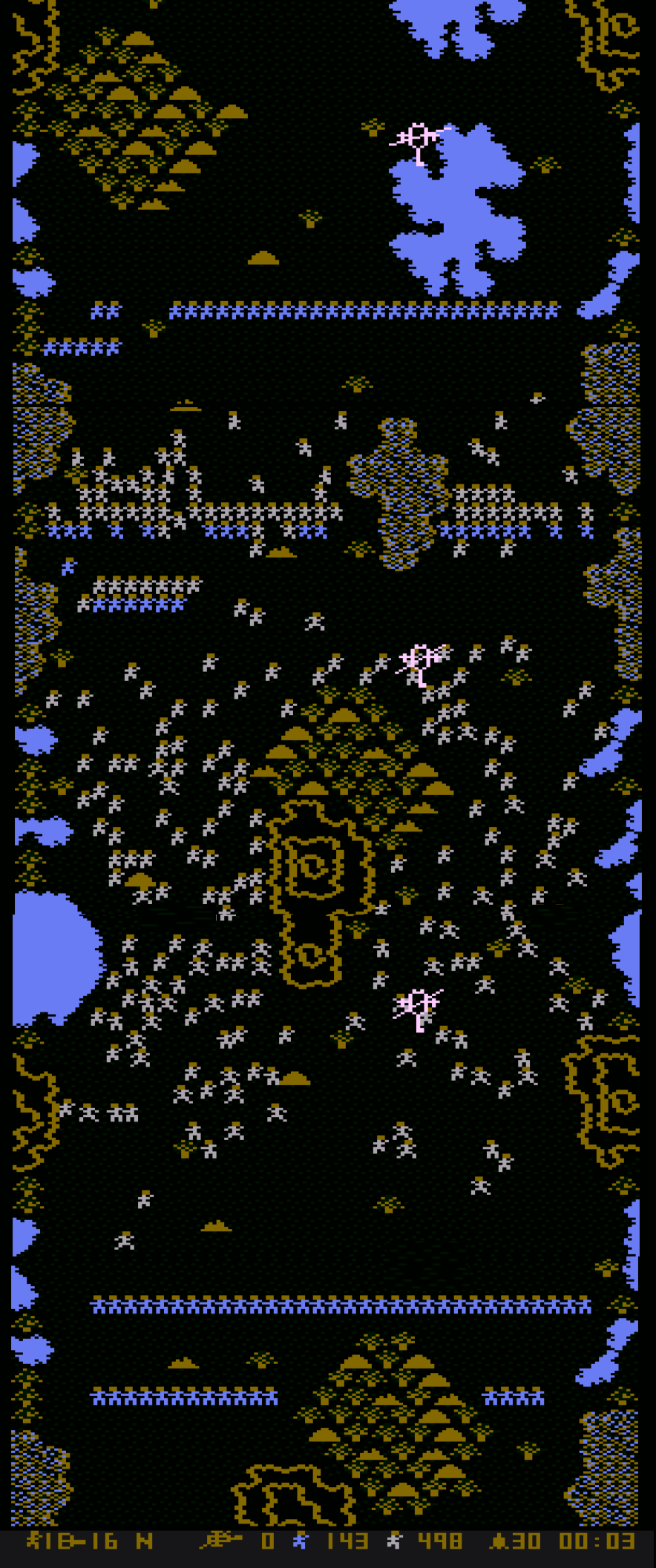
As a final issue, the game is long – I accelerated the game three times and I was still bored for most of it as I had to grind up to 700 enemy soldiers down to 0.
Did I make interesting decisions? No
Final rating: Totally obsolete. With a larger map, real objectives beyond “kill all robots” and no enemies teleporting behind your lines, Air Support could have been a decent game. As it was published, it’s quite simply boring.
Ranking at the time of review: 134/170. The immediate comparison is Rescue Raiders, which I did not like (and only BRIEFed), and Air Support is much worse as an arcade game and not better as a strategy game. However, the comment sections of Air Support on both Atarimania and Lemon64 have more comments than usual about how this was a favourite back then, so maybe you had to be there.
I have not been active a lot recently, due to a combination of minor health issues, closing stuff at work before the holidays, and my current infatuation with the roguelite puzzle-game Blue Prince. I will soon be leaving on vacation, so I am not sure I’ll be able to publish more than one other article before September.